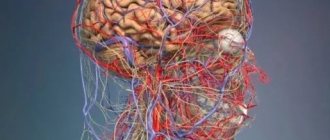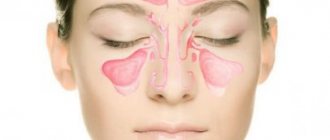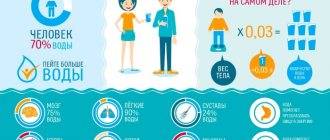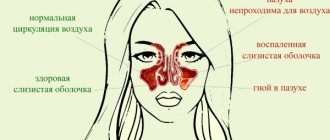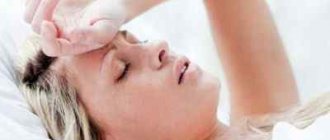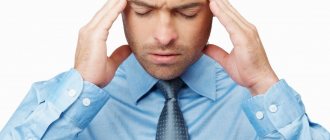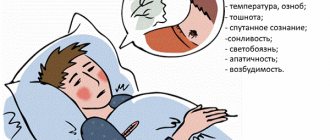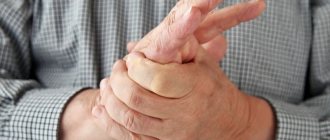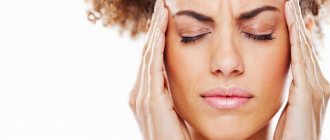According to some sources, there are up to 360 types of headaches. It is not the brain itself that hurts, as it often seems, but the more or less irritated nerves that accompany the blood vessels inside the skull. The cause of pain can be located both inside the head and in other parts of the body, from where the nerves transmit the pain signal to the brain.
In Western European countries, about 80% of women and 65% of men suffer from various types of headaches, which always occur with a certain frequency. Some representatives of the population indicate that the head can often hurt even for several days. Only up to 5% of the population declares the absence of unpleasant “encounters” with this disease. Before reaching the age of 15, approximately 75% of children experience headaches. In the group of children aged 5-7 years, about 30% suffer from migraine. Among 15-year-old representatives of the population, headache occurs in approximately 45% of cases.
Headache is most common among the female half of the population. 7 out of 10 people suffering from migraines are women. In addition, 6 out of 10 of them are under 45 years old. Headache, which occurs in children, usually persists into older and adulthood. There have been repeated cases, especially in relation to migraine, where the disease disappeared after reaching adulthood. It is important for parents not to neglect this problem, because... A child's health status can affect his or her success in school.
Causes
There can be many reasons for the appearance of a headache - from simple fatigue to problems requiring surgical intervention. Most often, a headache does not go away for the following reasons:
- stress caused by conflicts or anxiety;
- excessive physical activity;
- rheumatism in the neck;
- excessive use of alcohol or tobacco;
- changes in blood pressure;
- allergies or poisoning;
- drug exposure;
- weather dependence.
Coping with most of these factors is not difficult - a person just needs to change his lifestyle a little, react more calmly to difficulties and balance his diet.
However, in some cases this will not be enough and you will need to take specialized medications or the help of a qualified specialist. The latter is especially important, since self-medication can lead to worsening of the condition or loss of valuable time for medical care.
Doctors note that headaches may be one of the symptoms of the following health problems:
- brain tumor;
- bad teeth;
- diseases caused by parasites, etc.
There are also types of headaches that are not associated with other pathologies. These include:
- migraine;
- cluster headache.
As you can see from the list, the diseases are serious. That is why, if you have a severe headache (and especially if you have headaches every day) and pills do not help, diagnosis is necessary as early as possible in order to prevent complications in the future.
Migraine
This disease lasts a long time - from several hours to several days and is often hereditary. Most often women suffer from the disease. The causes of migraines are mainly sleep problems, hormonal changes, unbalanced nutrition and vascular pathologies. With a migraine, the pain usually has a pulsating nature and is focused on one side of the face.
The disease can be recognized by the symptoms that precede it:
- irritability;
- isolation;
- vomiting or nausea;
- aversion to bright light and noise.
In order for the headache to go away, some changes in diet are needed. Thus, experts recommend giving up alcohol, coffee, citrus fruits, smoked products, chocolate, eggs and cottage cheese. It is best to immediately consult a specialist when symptoms appear and undergo a full diagnosis of the body, based on the results of which a further course of treatment will be proposed. If this is not possible, then the following folk remedies can help:
- lemon peel, which is applied to the temporal areas;
- freshly squeezed potato juice;
- tincture based on clover leaves;
- blackcurrant juice, take 3-4 times a day;
- massage of the temporal areas using mint oil.
As a preventive measure, it is recommended to drink a glass of whey or yogurt every day before breakfast.
Cluster pain
The disease resembles the previous one, but differs in a smaller area of the painful area. As a rule, it occurs at one point of the head. Most often found in men with an athletic build. Characteristic features of the patient's appearance are usually: a square face shape, a cleft chin and light eyes. This type of headache does not occur in children.
Cluster pain is more acute than migraine pain. In addition, there is a burning sensation in the head in the eyebrow area and pain in the eyes. The pain may eventually spread to the ears, jaw, or temples. The duration of pain varies from several tens of minutes to several hours. In some cases, attacks may disappear for a long time. The symptoms of the disease are as follows:
- irritability;
- eyes water and turn red;
- pallor;
- nausea;
- nasal congestion;
- sweating
A possible cause of pain is a change in hormonal levels associated with impaired functioning of the hypothalamus.
Brain tumor
This tumor appears in the brain tissue and can be either malignant or benign. The latter can be cured without surgery. A malignant tumor grows very quickly and metastasizes. Therefore, the disease is difficult to treat, especially in the later stages.
With this disease, pain is felt constantly, and only intensifies during movement. The most severe pain occurs in the morning and at night due to the accumulation of excess fluid in the tissues. The nature of the pain is pressing, throbbing. In addition to the headache itself, other symptoms gradually appear:
- bouts of vomiting;
- dizziness;
- vision problems;
- impaired coordination of movements;
- numbness of the limbs;
- memory impairment;
- loss of consciousness;
- persistent signs of fatigue.
Treatment carried out at the initial stage has a much greater chance of success than in later stages. This is why it is recommended not to delay visiting your doctor. Sometimes the patient’s life depends on this. As a rule, radiation therapy and certain medications are prescribed. In some cases, surgery cannot be avoided. Treatment based on folk remedies does not help here. The maximum that can be achieved is to reduce the symptoms.
Poisoning
Sometimes pain occurs due to intoxication. You can be poisoned, for example, by fumes of toxic substances contained in clothing or furniture. To relieve pain, it is enough to get rid of problematic household items. However, the most common cause of headaches is food poisoning. If you suspect this disorder, you should:
- rinse the stomach;
- take activated carbon;
- drink a laxative.
These measures will help remove harmful substances from the body, as a result the pain will decrease or stop completely. In case of poisoning, headache pills do not help. In case of alcohol poisoning, it is recommended to drink some orange juice or mineral water.
Pressure drops
Unstable blood pressure, in addition to headaches, can lead to dizziness or even a stroke. If this problem occurs, be sure to contact a specialist. Having found the cause of blood pressure changes, he will prescribe appropriate medications.
How to recognize danger and why is it important?
The danger arises if the headache sharply worsens, vomiting is added to it, and disturbances of consciousness occur. If the attack intensifies after physical activity, your head hurts for several days, and you feel like you have “never experienced this type of pain before,” consult a doctor!
Treatment methods
When you have a headache, you don’t always need to rush to take medications. This can be addictive and in some situations will only make the pain worse. The best solution would be to do a light head massage, namely the forehead, temples and back of the head. Then it is advisable to go for a walk in the fresh air. Herbal tea with the addition of mint or motherwort will have a beneficial effect on the condition. But drinking coffee is not recommended.
When working, you need to change positions more often, use table lamps if necessary, and ventilate the room more often. Upon returning home, you should take a contrast shower and drink a glass of honey and milk. If all this does not help, then you need to take painkillers. However, remember that this should be done no more than once a week, so as not to become addictive.
Following these simple recommendations will help reduce pain or prevent its occurrence:
- the head should not get too cold, so you need to wear a hat or other headgear;
- try to find out the cause of the disease by consulting a specialist;
- try not to get depressed and maintain a positive attitude no matter what;
- healthy sleep is the key to your health;
- do not forget about periodic walks in the fresh air;
- in case of severe pain, avoid sudden movements and unpleasant odors;
- Take painkillers less often.
How to eliminate pain
What to do for severe and prolonged headaches? First of all, if unpleasant symptoms appear, you should definitely consult a doctor, he will prescribe an examination, which includes:
- blood sugar test;
- MRI and CT examination of cerebral vessels;
- X-ray of the cervical spine;
- Doppler ultrasound (mainly prescribed to women during pregnancy);
- hormone tests.
A consultation with a neurologist is also required, who can identify possible disorders of the nervous system.
To relieve attacks, analgesics, non-steroidal anti-inflammatory drugs and antispasmodics are often used. The dosage and duration of medication is prescribed by a specialist individually for each patient.
With prolonged coughing, the patient develops a headache as a side effect; in this case, taking antitussive drugs is indicated.
If the headache is caused by nervous disorders, then I use antidepressants and sedatives for therapy. If a tumor is detected in the brain, it is removed and histological examination is performed. If malignancy is confirmed, a course of chemotherapy or radiation therapy is carried out.
General recommendations
At the first signs of cephalalgia, cool compresses on the forehead and complete rest will help get rid of the pain. The pain often goes away on its own (unless it is caused by serious disorders). If the cause of the attack was a jump in blood pressure, then you need to take a drug to stabilize it.
To saturate the brain with oxygen, it is recommended to ventilate the room in which the patient is located, or take a short walk in the fresh air. If after this the pain does not go away, then you need to take a non-steroidal anti-inflammatory drug or antispasmodic.
As first aid, you can do a light head massage, stretch your neck a little, and drink sweet herbal tea to help you relax.
During a severe headache, it is strictly forbidden to drink alcohol or perform physical work associated with serious stress. When working at a computer for a long time, you should not tilt your head too much towards the keyboard and it is recommended to warm up a little from time to time (walk around the office, squat, etc.).
Often, in addition to drug therapy, doctors prescribe a set of physiotherapeutic procedures. It includes therapeutic massage, a visit to a chiropractor (used in complex therapy, the doctor acts on certain areas of the body, resulting in a pain attack being relieved), acupuncture (improvement is observed after several sessions), exercise therapy, etc.
Ultrasound treatment, magnetic and heat therapy will be useful. For diseases of the cerebral vessels, the patient undergoes extracorporeal hemocorrection. Thanks to this procedure, cholesterol plaques are cleared and the risk of thrombosis is reduced.
Also, thanks to this technique, autoantibodies are removed from the blood, which cause multiple sclerosis and other disorders in the functioning of the immune system. The type of procedure depends on the disease that causes long-term, daily headaches.
Diet correction
If the pills do not help get rid of painful attacks, you need to adjust your diet. The following products are prohibited:
- smoked products and cheese, which contain the amino acid tyramine, which is the cause of headaches;
- chocolate and products containing it. They contain phenylethylamine, which causes attacks of pain; Chinese spices and products;
- all types of sausages, in the production of which nitrites are often used; nuts;
- alcoholic drinks;
- sweets, carbonated drinks and other products that contain aspartame.
It is best to eat fresh vegetables and fruits, which are rich in vitamins and microelements. You should consult a nutritionist about the correct selection of diet.
Today, treatment of migraines with Botox injections is very popular. The substance is injected into the area of the spasmed muscle, this allows you to relieve an attack of pain and has a relaxing effect.
Many patients claim that nothing helps them except traditional medicines. This is a rather controversial issue.
Among the methods of alternative medicine are:
- aromatherapy (the use of essential oil vapors to relieve headaches);
- warm baths with lavender, eucalyptus and sea salt;
- infusions and decoctions of medicinal plants (chamomile, mint, etc.);
- herbal tea based on lemon balm, motherwort, valerian.
It is often enough to drink a glass of warm milk with honey and go to bed, and the next morning the pain will go away. A massage using lavender or mint essential oils gives a relaxing effect and will help get rid of unpleasant sensations.
Very often, patients use clay wraps, to which you can add a little menthol oil. Such a compress is placed on the painful area, and after a while the unpleasant symptoms disappear.
You should not get carried away with traditional medicine methods, as this can cause undesirable consequences, because the causes of headaches can be serious pathologies in the body that require professional help from a specialist.
Rejection of bad habits
It is strictly forbidden to do the following in case of prolonged headaches:
- drink alcoholic beverages. Ethyl alcohol provokes vasodilation and increases pain;
- smoke. The nicotine contained in cigarettes causes a spasm of the blood vessels of the brain and causes a new attack of pain;
- apply ice compresses (in case of hypertension, this can cause rupture of a vessel and lead to a stroke);
- use a repeat dose of the analgesic drug if there is no improvement the first time. In this case, you can provoke an overdose and the development of side effects.
You also need to remember that a headache can be a symptom of a serious illness, so you should not get carried away with self-medication.
Folk remedies
Hawthorn and oregano with the addition of lemon are good for headaches. The decoction is prepared by adding a tablespoon of one of the herbs, lemon and a spoon of honey (optional) to a container of boiling water. Next, you need to let the product brew, then take it 50 ml 15 minutes before meals 2-3 times a whole day. A popular folk remedy is taking baths with infusions of aromatic herbs and lemon balm.
How is migraine treated?
They just don't treat it. And folk remedies, and prescription medications, and even Botox injections.
ethnoscience
Some people with migraines find relief from folk remedies ranging from lavender oil to chewing ginger root. It's relatively safe, so you can try alternative means before bringing in the big guns.
Some studies have confirmed that butterbur may be quite effective in relieving migraines. Tansy, magnesium, coenzyme Q10 and vitamin B2 are also often recommended.
But remember - trace elements can be unsafe, and herbs are far from harmless. Talk to your doctor about whether you should experiment with these remedies.
Medicines
Any medications, even those that can be bought without a prescription, must be prescribed to you by a doctor.
We will take a broad look at this clearing: non-steroidal anti-inflammatory drugs, triptans, steroids, painkillers and other drugs are usually used to treat migraines.
State Description
Sometimes the pain in the head is so strong and acute that it literally paralyzes a person. He experiences unpleasant discomfort when trying to blink, irritability appears, noises in his head, and his temples begin to pulsate. In this condition, the only thing you want to do is take a medicine that would help eliminate the unpleasant pain and normalize the condition. But in some cases, it happens that the head hurts and the pills do not help.
About 15 percent of people experience headaches in childhood. Doctors say that for every 100 people complaining of pain, about 5 of them regularly experience acute pain due to the presence of developing diseases in the body. It is important to remember that this symptom never appears just like that; most often it is associated with a migraine or severe overexertion.
Types and causes of long-term headaches
In order to understand why you have a headache for several days in a row, you must first consider the main types of pain syndromes:
- vascular;
- neuralgic;
- tension (due to severe muscle tension).
Each of these types of pain manifests itself differently in patients: sometimes the attack can pass in a few hours, and sometimes it lasts for several days or months on end (for example, migraine). The main cause of pain is problems with the nervous system.
An attack can be triggered by poor circulation, a brain tumor, or injury. In this case, the intensity of the pain syndrome will constantly change. The main factors that cause long-term cephalalgia are:
- hypertension, hypertension;
- migraine;
- meningitis or encephalitis;
- consequences of alcohol intoxication;
- viral and infectious diseases;
- sinusitis, etc.
Very often, headaches occur due to a lack of oxygen, increased intracranial pressure, diseases of the central nervous system, poor nutrition, and due to the effect of toxic agents on the body (for example, when inhaling vapors containing harmful chemical compounds). Often unpleasant symptoms occur due to incorrectly selected glasses, noise or too bright lighting.
When hemoglobin levels decrease, insufficient oxygen reaches the brain, which causes the patient to experience dizziness, loss of consciousness, and severe fatigue. This condition will last until the indicator returns to normal.
Often the patient is diagnosed with “psychalgia” - this is a pathological condition in which pain is constantly felt in different places. First of all, this disease is associated with mental problems (depression, stress, etc.).
It is important to note that the source of pain is not in the brain itself, but in its membranes, muscles, blood vessels, and the periosteum of the skull. One type of long-term headache is migraine.
In this case, unpleasant sensations are localized only on one side and intensify during movement or exercise. In order to accurately determine the cause of the attack, in addition to being examined by a doctor, it is necessary to undergo additional examinations.
Causes of pain
Why does my head hurt and pills don’t help? To find out the cause, you need to make an appointment with a doctor. This is especially necessary if a person constantly has a headache and pills do not help. A specialist will help determine the exact cause of the lesion and prescribe effective treatment. Any specialist can confirm that headache is a possible symptom of a large number of diseases, so there are many reasons for its occurrence. The main causes of headaches in adults:
- glaucoma;
- migraine;
- myopia;
- head injury, bruise;
- cluster pain;
- fatigue, excessive stress on the body both mentally and physically;
- increased blood pressure;
- damage by a virus or infection.
My head hurts a lot, pills don't help
Pain treatment with massage: the most effective health tips
Modern medicine offers many drugs to combat pain. Of course, this is a huge advantage of our time. However, it also makes us too lazy in relation to our own health.
When we feel a little pain, we immediately reach for a pill, without thinking that this is just a temporary solution to the problem. And besides, not without negative side effects.
But there are alternative treatment methods available to every person and in absolutely any conditions. One of them is massage, which also helps in the treatment of various types of pain, not to mention its properties of recovery from fatigue and loss of joint flexibility, which is an extremely important factor in the overall health of the human body.
Lack of time (or money) to regularly visit a massage therapist does not mean that you need to give up the idea of making massage a part of your healthy life. Massage yourself! But, of course, it will be better and more effective if this is done by professionals, who today can be selected to suit your conditions without leaving home thanks to the Internet, namely online services. Massage itself may not always bring the desired result, but salt therapy, as you know, can. and may actually make the situation worse. It’s better to trust a pro in such cases.
Well, we move on...
Massage of the hands and feet has a beneficial effect on the entire body.
Our body is not a collection of separate, unconnected pieces. This is a single, interconnected biosystem. So, tension in the feet leads to tension in the knees, which in turn causes tension in the pelvis and abdomen. This impairs blood flow; blood circulates worse between the brain and limbs. Result: pain, poor digestion, dizziness, etc.
• It is worthwhile to linger on each finger separately: massage their pads, walk from the base of the fingers upward. This is especially true for the thumb - it corresponds to the head and neck.
• Don't forget the inner edge of the foot. It is believed that it corresponds to our spine.
• It is useful to also engage the muscles of the lower leg.
The same goes for brushes.
• If you are giving a massage to another person, take his hand in both hands and, using rubbing movements, slide it over the palm, the back of the hand, gently kneading the bones between the phalanges.
• Massage your fingers. Healers claim that the upper part of each finger corresponds to certain parts of the brain.
• Pay special attention to the point between your thumb and index finger. It is responsible for the tone of the whole body. In most cases, pressing on it is painful, so massage gently, gradually increasing the impact. This point should be massaged whenever you feel a headache coming on.
There is nothing easier and safer than massaging the feet and hands of your loved ones - or your own.
It is better to use a little oil (baby cream will also work) to make your hands glide a little.
So, let's begin.
• Take your foot in your hands and begin to rub your fingers along the sole, Achilles tendons, and the area around the ankle.
You yourself will feel that some places react very painfully. These may be points that, according to the teachings of Eastern healers, are a projection of internal organs. Don't put too much pressure on them. Nevertheless, continue, the pain will become less.
https://healer-beauty.ru/
Description of vascular pain
This type of pain can occur as a result of subarachnoid hemorrhage (bleeding into the so-called subarachnoid space) or a hemorrhagic stroke of the brain.
Patients say that such pain is the most severe, it is almost impossible to endure. Migraine is also considered a form of pain; it provokes a strong dilation of the blood vessels in the brain. As a result, they greatly increase in size and put pressure on the sensitive receptors of the brain. These include vision problems, severe fatigue, sudden mood swings, aggressiveness, muscle weakness, and malaise like a cold.
What are the risk factors?
Women are more likely to get migraines than men.
However, a prepubertal boy is more likely to have it than a girl.
The risk of migraine increases with depression, menopause and a related family history.
What are triggers?
If you are prone to migraines, it is quite likely that the reason for the onset of an attack will be a certain trigger (“trigger” in the literal translation).
Most common triggers:
- Hormonal changes (for example, corresponding to the menstrual cycle)
- Lack of sleep or jet lag
- Stress
- Bright lights
- Irritating or chemical odors
- "Hangover" after drinking caffeine
- Medical conditions (such as iron deficiency anemia)
- Infections
- Hunger
- Use of medications
- Anxiety
Blunt pain
A distinctive feature of such pain is that it occurs in the morning after waking up, regardless of whether the person had a good rest at night or not. The localization of the unpleasant symptom is in the back of the head. This indicates increased blood pressure, which is the main symptom of hypertension. If the described problems are present, it is important for the patient not to wait, but to immediately consult a doctor, who will begin to closely monitor the blood pressure. The doctor will formulate the correct treatment and change the patient’s lifestyle.
Prevention
First of all, for prevention it is necessary to establish and treat the true cause that causes headaches. It is recommended to monitor your lifestyle, do exercises in the morning and evening, eat right, and do not abuse alcohol and smoking.
To reduce the risk of developing nervous disorders, stressful situations should be avoided. It is imperative to monitor your posture, not slouch, and choose the right mattress and pillow for sleeping. At the first unpleasant symptoms, it is recommended to immediately contact a medical facility.
Source
Pain after a head injury
Severe pain in the head occurs after receiving a serious injury or bruise; in this case, it is important to immediately report the problem to a doctor. After receiving an injury, the patient may not feel any unpleasant symptoms, but after returning home he will experience nausea, vomiting, headaches and other symptoms indicating brain damage or a concussion. If you receive an injury, it is important, without waiting for unpleasant symptoms to appear, to immediately go to the clinic to see a doctor, who will help avoid the development of complications and other negative consequences.
Tumor formations in the head
In the presence of tumors, the pain is constant. Additionally, the patient experiences nausea and vomiting. The intensity of the pain does not change, it is constant and occurs in the morning and continues throughout the day. The pain becomes acute only after several months, in some cases weeks. This condition usually indicates the initial stage of tumor development. It is important to begin treating headaches in adults immediately. It is preceded by sensory disorders, epileptic seizures and tremors.
The described types of lesions will help the patient to orientate well and evaluate the whole situation when he has a headache and pills do not help.
What questions do patients most often ask about migraine?
As a rule, says neurologist, co-founder of the University Headache Clinic Yulia Azimova, a person with migraine has already visited more than one doctor and he already has the results of examinations and instructions about his disease. At the conference, she named the most common questions patients ask.
Everywhere they write that with migraine, first the blood vessels narrow, then dilate. How to treat blood vessels? - No way.
Most patients associate the appearance of headaches with the fact that the blood vessels first narrow and then dilate, and conclude that they need to treat the blood vessels. But it's not really related.
The Danish Headache Center conducted a systematic analysis of 17 studies and found no changes in blood flow - neither in migraine with or without aura, nor in chronic migraine, nor in episodic migraine, neither during attacks nor between attacks. There are no changes.
I have osteochondrosis. Could this give me a headache? - No.
“Not a single patient has yet come to me with an ultrasound or MRI report so that it says: “You are fine,” notes Azimova. “We see some changes in the conclusion and are critical of them.”
According to experts, neck pain occurs in 76% of migraine patients, but this is only one of the symptoms of migraine, and not its cause. This is caused by the fact that during a headache attack, the nerve associated with the upper cervical spine is activated, so the patient may feel pain in this area.
Why do I have a migraine? — Disturbances at the molecular level.
The honest answer is that science does not know the causes of migraines, but some pieces of the puzzle are already known that may provide answers to certain questions. The cause of headaches is associated with congenital structural features of nerve cells at the molecular level.
Under the influence of triggers - stress, sleep disturbances, hormonal changes - nerve cells become excitable. In response to this, a headache conductor is released - the neurotransmitter protein CGRP. “It’s like wires, and the part that is responsible for delivering pain information begins to spark and work excessively,” explains the doctor.
Migraine is not associated with structural disorders, but nevertheless there are prerequisites and a hereditary predisposition to it, says Azimova.
What then is the treatment? - It depends on what.
There are three main directions in the treatment of headaches: relieving an attack, preventing its occurrence in the future and, if necessary, treating concomitant diseases that affect migraine - depression, anxiety disorders, sleep disorders.
Development of migraine
Migraine is considered a serious cause of headaches. With this disease, the pain syndrome spreads to one part of the head. The symptoms are very pronounced, there is throbbing, acute pain, vomiting and nausea, a negative reaction to any sound and light signals. This condition can last for several hours or even days.
Migraine is a hereditary disease. It affects about 15 percent of all patients. Most often, it is women who are included here, but men also suffer from this defeat. Doctors assure that it is impossible to completely get rid of migraines, but there are methods that will help significantly reduce the manifestation of unpleasant symptoms.
With migraine, pain in the head occurs due to the fact that the blood vessels of the brain greatly dilate, which leads to irritation of the receptors. Lack of sleep, problems in the production of hormones - all this can lead to vasodilation.
If a person often experiences migraine attacks, then it is important for him to stop drinking alcoholic beverages, as well as unhealthy foods: confectionery, red wine, processed foods, citrus fruits and smoked meats.
Eggs and cottage cheese can also provoke pain, so it is better to limit their consumption. You should not drink more than one cup of coffee per day. In the pharmacy you can find a large number of headache medications that will help eliminate migraine attacks and normalize a person’s condition.
Migraine
Migraine is a chronic disease based on the functioning of blood vessels, manifested as a result of their narrowing and then dilation.
This is a very common disease, manifested by attacks that occur at varying intervals (they can last up to 3 days). Several symptoms often indicate an approaching migraine attack. They may appear several days or even hours before the attack begins; include mainly sensitivity to environmental stimuli, restlessness, irritability, poor sleep, and stiff neck. Some people develop a taste for certain foods.
Sometimes an attack is preceded by an aura. We are talking about several minutes of visual sensations in some parts of the visual field, which change depending on eye movement and can even increase. The area may flicker or shimmer. At the same time or within a few minutes after the aura disappears, pain appears. The physical symptoms of an aura usually last 5-60 minutes. Usually disappears shortly before the attack itself, but sometimes persists even after the onset of pain.
Fighting methods
What to do if you have a severe headache? Head pain should not be treated with medications alone. They can cause rapid addiction in the body, which will only give a temporary effect. Any medication puts a lot of stress on the human body. The best solution would be a massage for headaches in the temporal region and forehead, as well as getting fresh air. To get rid of pain, you should drink tea with mint and motherwort. But you should not drink instant coffee, as it will only have a temporary effect, after which the pain will return.
Why can a different diagnosis be made instead of migraine?
According to 2012 US data, only 26% of people with episodic migraine receive proper treatment, and even fewer, just 5%, for chronic migraine. There are no similar statistics for Russia, but, according to experts, the situation in the country is hardly better.
There is Federal Law No. 323 “On the Protection of Citizens’ Health,” which states that treatment must be carried out according to certain standards. The standards spell out how to diagnose migraine: the patient needs to take a general blood test, a general urinalysis, an X-ray of the skull in two projections, an MRI of the neck and head. Often, patient tests show minimal changes, such as osteochondrosis of the cervical spine, tortuosity of the carotid or vertebral arteries. “It’s hard for a doctor to ignore this. He saw that the radiologist described osteochondrosis of the cervical spine, did not filter it out and transferred it to the diagnosis, linking it with the patient’s complaints,” suggests Kirill Skorobogatikh. And in some cases, diagnosis goes the wrong way.
“We, in Russia, unfortunately, have diagnoses such as vegetative-vascular dystonia, osteochondrosis, neurocirculatory dystonia, dyscirculatory encephalopathy - diagnoses that are not in the international classification of diseases, this is our peculiarity.
And there, into the cauldron of these diagnoses, a bunch of diseases fall
There may be dizziness, depression, anxiety, and headaches,” the doctor notes.
In addition, insurance companies, both public and private, also contribute. “Insurers have their own views on some diagnoses and whether or not they pay for certain research methods. Therefore, the doctor always has to pass between Scylla and Charybdis in a very short period of time, so as not to crash into either one or the other rock,” adds Skorobogatikh.
Treatment at home
Headache in the temples - how to get rid of it? In this case, you should use the following tips:
- If the pain is acute, and there is a lot of time left before going to the doctor, then you can take emergency measures: take a warm bath with chamomile decoction (this method is prohibited from using at high body temperature).
- Take a break from working at the computer. If the pain occurs as a result of overexertion, it will quickly go away.
- Relax and drink lemon balm tea.
What causes a child to have a headache for several days in a row?
Children's complaints of pain should be treated with special attention, since due to their young age they are not able to accurately describe the symptoms and seek help in time. Causes of pain in a child:
- migraine, as a genetic disease, manifests itself already in childhood;
- neuralgic problems are characterized by sharp or dull painful sensations in the temples and back of the head;
- injuries are common in children, but headaches will be a serious concern;
- external factors - headaches can also hurt.
Headache massage
A patient who wants to carry out such a procedure regularly, but does not want to do everything on his own, can make an appointment with a massage therapist. If a person has a headache and pills do not help, then self-massage can achieve a good effect. The main advantages of this procedure:
- has a relaxing effect, helps reduce muscle tension;
- During this procedure, the upper layers of the skin warm up well, normal blood circulation is restored;
- with acupressure, the body reflexively responds to external action, resulting in a good analgesic effect;
- With regular massage, a person's muscle tone is restored and pain goes away.
A massage against head pain is best performed by a professional who will take into account the patient’s personal characteristics, the nature of the disease, and also select the optimal strength of influence.
How to avoid migraines?
The main way to combat migraines is prevention.
The symptoms and triggers of attacks are very diverse, so only you can determine exactly how to act to prevent migraines.
Here are general recommendations:
Avoid triggers
You might want to keep a notebook to help you identify your individual triggers. Most likely, this will not be too difficult - the most common reasons are lack of sleep and stress.
Take preventive medications
If you get migraines more than five times a month and situational medications don't help with the pain, you may need to take preventative medications.
For this purpose, both specialized drugs and those formally indicated for other diseases are used.
These include antidepressants, anticonvulsants, oral contraceptives, antihypertensives, etc.
Discuss this option with your doctor.
Use special procedures
Acupuncture, massage, relaxation, psychotherapy, and even Botox injections can be helpful for migraines!
Adjust your lifestyle
If you live with migraines, you will have to give up your daily community service and focus on yourself.
Rest more, pay more attention to your well-being, and plan your workload more carefully.
The most useful skill for you will be to record the phases of a migraine attack in order to take your medication on time and adjust your plans.
Technique
If a person has a headache and pills do not help, then a traditional head massage will effectively eliminate the pain that appears as a result of nervous strain. You can do it yourself using the following technique:
- First, for 3-4 minutes, the scalp is slowly rubbed and warmed with light circular movements of the fingertips from the back of the head to the temples. Over time, the pressure becomes stronger.
- From the temples from bottom to top, stroke in a spiral - from ear to ear. First with the pads of your fingers, then with your knuckles.
- The skin of the temples is rubbed with the index and middle fingers, movements are careful and slow.
- The area near the ears is massaged with a spiral from the temple to the back of the head.
- From the middle parting, move your fingers from top to bottom. The thumbs rest on the area behind the ear.
- Afterwards, spiral rubbing is immediately carried out with four fingers. Particular attention is paid to the pressure of the thumbs; pressing hard behind the ear is prohibited.
Microstroke in humans
If you have a headache for the second day and the pills do not help, then a microstroke can be suspected. Some doctors believe that with this condition, a microscopic area of the brain dies, others believe that with such a lesion, blood circulation in some part of the brain stops for a certain period of time. No head medications really help in this case.
Doctors have come up with a separate definition of such a lesion: a microstroke is a temporary, lasting less than a day, lack of oxygen in a separate area of the brain. It is important to identify the main first signs and symptoms of a microstroke.
What to do?
Pain always appears at the most inopportune moment, so rarely is anyone prepared for it. Only after a series of attacks can the optimal remedy be found. If you have regular pain, do not delay visiting your doctor.
Diagnosis of the disease
A headache indicates another disease that provokes it, or the presence of sensitivity to weather changes. Symptoms and modern diagnostics will help to detect this or that deviation from the norm.
During the initial examination, the doctor makes a preliminary diagnosis based on the clinical picture and refers to a specialist of the appropriate profile. If there are serious reasons, then instrumental diagnostics are prescribed:
- EEG detects fluctuations in electrical potentials in the brain;
- examination of the fundus by an ophthalmologist for the presence of a number of pathologies;
- MRI gives a picture of the state of all brain activity and reveals abnormalities in the early stages;
- Doppler ultrasound is a method that determines the condition of the vessels of the head and spine in the cervical region (if the back of the head hurts).
Quick help
If you feel unwell, it is better to lie down and protect yourself from irritants. If this does not help and the headache does not go away, then they resort to medications. It is necessary to assess the situation and exclude diseases causing pain, then take the necessary medications.
If there is a feeling of depression, the patient is wobbly and pale, and it hurts to swallow, then this means that he has a cold or another viral disease.
When do pills not help?
Tablets do not help in two cases:
- if the medicine is chosen incorrectly;
- if you have developed an addiction to one of them.
| Nurofen | Used to relieve pain. Take one tablet after meals, 3-4 times if necessary. On the fourth day, it is better to stop using it and consult a doctor. |
| Tempalgin | Adults: 1-3 tablets per day, no more than 3-5 days. Contraindicated during pregnancy. |
| Citramon | Take 1 tablet, no more than 3 per day, you can take it for the third day in a row. |
How to get rid of it using folk remedies?
Before the invention of analgesics, people who suffered from illness all day long used herbs, infusions and massages to relieve pain. A simple and popular method is mint tea, it calms and relieves spasms.
Some people apply pieces of lemon peel to their temples, then they should be removed after 10-15 minutes to avoid irritation.
